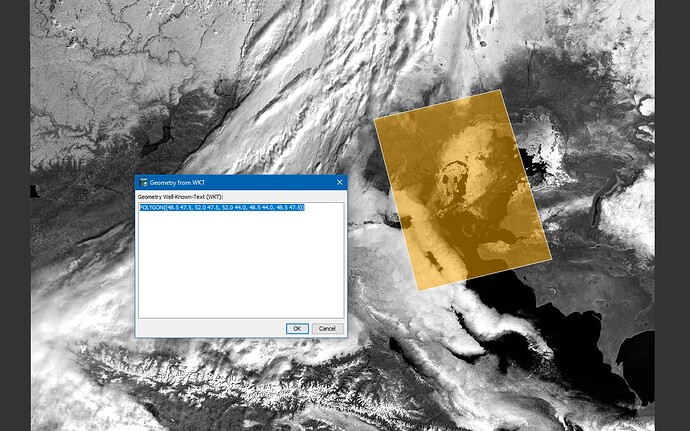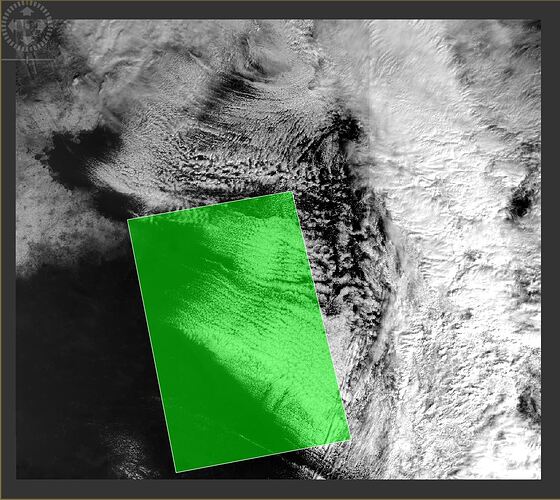Dears,
I am trying to create subset of sentinel3 images using the subset command from the graph processing tool: the idea is to extract a portion of an images, keeping all the bands, masks and metadata related to the extracted image portion in the .SEN3 native format.
I would like to know if its possible to keep the native format of the sentinel3 data after subseting:
ie: the data rep (with .SEN3) containing all the .nc and related manifest
I have made a xml file containing the required info, launched a first test
and It works but the output format is completely changed.
I cannot find clear info on how to do this : my input files contains this:
geo_coordinates.nc Oa02_radiance.nc Oa05_radiance.nc Oa08_radiance.nc Oa11_radiance.nc Oa14_radiance.nc Oa17_radiance.nc Oa20_radiance.nc removed_pixels.nc tie_meteo.nc
instrument_data.nc Oa03_radiance.nc Oa06_radiance.nc Oa09_radiance.nc Oa12_radiance.nc Oa15_radiance.nc Oa18_radiance.nc Oa21_radiance.nc tie_geo_coordinates.nc time_coordinates.nc Oa01_radiance.nc Oa04_radiance.nc Oa07_radiance.nc Oa10_radiance.nc Oa13_radiance.nc Oa16_radiance.nc Oa19_radiance.nc qualityFlags.nc tie_geometries.nc xfdumanifest.xml
but my output file contains this:
altitude.hdr FWHM_band_17.img FWHM_band_7.hdr lambda0_band_17.img lambda0_band_7.hdr Oa06_radiance.img Oa17_radiance.hdr solar_flux_band_14.img solar_flux_band_4.hdr
altitude.img FWHM_band_18.hdr FWHM_band_7.img lambda0_band_18.hdr lambda0_band_7.img Oa07_radiance.hdr Oa17_radiance.img solar_flux_band_15.hdr solar_flux_band_4.img
detector_index.hdr FWHM_band_18.img FWHM_band_8.hdr lambda0_band_18.img lambda0_band_8.hdr Oa07_radiance.img Oa18_radiance.hdr solar_flux_band_15.img solar_flux_band_5.hdr
detector_index.img FWHM_band_19.hdr FWHM_band_8.img lambda0_band_19.hdr lambda0_band_8.img Oa08_radiance.hdr Oa18_radiance.img solar_flux_band_16.hdr solar_flux_band_5.img
frame_offset.hdr FWHM_band_19.img FWHM_band_9.hdr lambda0_band_19.img lambda0_band_9.hdr Oa08_radiance.img Oa19_radiance.hdr solar_flux_band_16.img solar_flux_band_6.hdr
frame_offset.img FWHM_band_1.hdr FWHM_band_9.img lambda0_band_1.hdr lambda0_band_9.img Oa09_radiance.hdr Oa19_radiance.img solar_flux_band_17.hdr solar_flux_band_6.img
FWHM_band_10.hdr FWHM_band_1.img lambda0_band_10.hdr lambda0_band_1.img latitude.hdr Oa09_radiance.img Oa20_radiance.hdr solar_flux_band_17.img solar_flux_band_7.hdr
FWHM_band_10.img FWHM_band_20.hdr lambda0_band_10.img lambda0_band_20.hdr latitude.img Oa10_radiance.hdr Oa20_radiance.img solar_flux_band_18.hdr solar_flux_band_7.img
FWHM_band_11.hdr FWHM_band_20.img lambda0_band_11.hdr lambda0_band_20.img longitude.hdr Oa10_radiance.img Oa21_radiance.hdr solar_flux_band_18.img solar_flux_band_8.hdr
FWHM_band_11.img FWHM_band_21.hdr lambda0_band_11.img lambda0_band_21.hdr longitude.img Oa11_radiance.hdr Oa21_radiance.img solar_flux_band_19.hdr solar_flux_band_8.img
FWHM_band_12.hdr FWHM_band_21.img lambda0_band_12.hdr lambda0_band_21.img Oa01_radiance.hdr Oa11_radiance.img quality_flags.hdr solar_flux_band_19.img solar_flux_band_9.hdr
FWHM_band_12.img FWHM_band_2.hdr lambda0_band_12.img lambda0_band_2.hdr Oa01_radiance.img Oa12_radiance.hdr quality_flags.img solar_flux_band_1.hdr solar_flux_band_9.img
FWHM_band_13.hdr FWHM_band_2.img lambda0_band_13.hdr lambda0_band_2.img Oa02_radiance.hdr Oa12_radiance.img solar_flux_band_10.hdr solar_flux_band_1.img tie_point_grids
FWHM_band_13.img FWHM_band_3.hdr lambda0_band_13.img lambda0_band_3.hdr Oa02_radiance.img Oa13_radiance.hdr solar_flux_band_10.img solar_flux_band_20.hdr vector_data
FWHM_band_14.hdr FWHM_band_3.img lambda0_band_14.hdr lambda0_band_3.img Oa03_radiance.hdr Oa13_radiance.img solar_flux_band_11.hdr solar_flux_band_20.img
FWHM_band_14.img FWHM_band_4.hdr lambda0_band_14.img lambda0_band_4.hdr Oa03_radiance.img Oa14_radiance.hdr solar_flux_band_11.img solar_flux_band_21.hdr
FWHM_band_15.hdr FWHM_band_4.img lambda0_band_15.hdr lambda0_band_4.img Oa04_radiance.hdr Oa14_radiance.img solar_flux_band_12.hdr solar_flux_band_21.img
FWHM_band_15.img FWHM_band_5.hdr lambda0_band_15.img lambda0_band_5.hdr Oa04_radiance.img Oa15_radiance.hdr solar_flux_band_12.img solar_flux_band_2.hdr
FWHM_band_16.hdr FWHM_band_5.img lambda0_band_16.hdr lambda0_band_5.img Oa05_radiance.hdr Oa15_radiance.img solar_flux_band_13.hdr solar_flux_band_2.img
FWHM_band_16.img FWHM_band_6.hdr lambda0_band_16.img lambda0_band_6.hdr Oa05_radiance.img Oa16_radiance.hdr solar_flux_band_13.img solar_flux_band_3.hdr
FWHM_band_17.hdr FWHM_band_6.img lambda0_band_17.hdr lambda0_band_6.img Oa06_radiance.hdr Oa16_radiance.img solar_flux_band_14.hdr solar_flux_band_3.img
Could you please provide some advises.
thank you in advance
best regards,
Yoann


